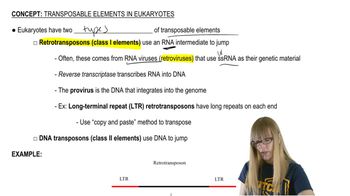Table of contents
- 1. Introduction to Genetics51m
- 2. Mendel's Laws of Inheritance3h 37m
- 3. Extensions to Mendelian Inheritance2h 41m
- 4. Genetic Mapping and Linkage2h 28m
- 5. Genetics of Bacteria and Viruses1h 21m
- 6. Chromosomal Variation1h 48m
- 7. DNA and Chromosome Structure56m
- 8. DNA Replication1h 10m
- 9. Mitosis and Meiosis1h 34m
- 10. Transcription1h 0m
- 11. Translation58m
- 12. Gene Regulation in Prokaryotes1h 19m
- 13. Gene Regulation in Eukaryotes44m
- 14. Genetic Control of Development44m
- 15. Genomes and Genomics1h 50m
- 16. Transposable Elements47m
- 17. Mutation, Repair, and Recombination1h 6m
- 18. Molecular Genetic Tools19m
- 19. Cancer Genetics29m
- 20. Quantitative Genetics1h 26m
- 21. Population Genetics50m
- 22. Evolutionary Genetics29m
7. DNA and Chromosome Structure
DNA as the Genetic Material
Problem 20
Textbook Question
How is the absorption of ultraviolet light by DNA and RNA important in the analysis of nucleic acids?
 Verified step by step guidance
Verified step by step guidance1
Understand that nucleic acids, such as DNA and RNA, absorb ultraviolet (UV) light due to the presence of aromatic bases (adenine, guanine, cytosine, thymine, and uracil).
Recognize that the absorption of UV light by nucleic acids is typically measured at a wavelength of 260 nm, which is the peak absorption for these molecules.
Learn that the absorbance at 260 nm can be used to estimate the concentration of nucleic acids in a solution using the Beer-Lambert Law, which relates absorbance to concentration.
Note that the ratio of absorbance at 260 nm to absorbance at 280 nm (A260/A280) is used to assess the purity of nucleic acid samples, with a ratio of ~1.8 for DNA and ~2.0 for RNA indicating relatively pure samples.
Understand that changes in UV absorption can also indicate structural changes in nucleic acids, such as denaturation, which can be important for studying nucleic acid stability and interactions.
 Verified video answer for a similar problem:
Verified video answer for a similar problem:This video solution was recommended by our tutors as helpful for the problem above
Video duration:
2mPlay a video:
Was this helpful?
Key Concepts
Here are the essential concepts you must grasp in order to answer the question correctly.
Ultraviolet (UV) Light Absorption
DNA and RNA absorb ultraviolet light, particularly at a wavelength of 260 nm. This property is due to the presence of aromatic bases in their structure, which can transition to an excited state upon absorbing UV light. This characteristic is crucial for quantifying nucleic acids in laboratory settings, as the amount of light absorbed correlates with the concentration of nucleic acids present in a sample.
Recommended video:
Guided course

DNA Proofreading
Nucleic Acid Analysis Techniques
Various techniques, such as spectrophotometry, utilize the UV absorption properties of nucleic acids to analyze their concentration and purity. By measuring the absorbance at 260 nm and comparing it to absorbance at 280 nm, researchers can assess the ratio of nucleic acids to proteins, which is essential for ensuring sample integrity before further experimentation.
Recommended video:
Guided course

Chi Square Analysis
Significance of Nucleic Acid Integrity
The integrity of nucleic acids is vital for accurate analysis and downstream applications, such as cloning, sequencing, and PCR. Degradation of DNA or RNA can lead to erroneous results, making it essential to evaluate the quality of nucleic acids through their UV absorption characteristics. High-quality nucleic acids will show a clear absorbance peak at 260 nm, indicating minimal degradation.
Recommended video:
Guided course

Eukaryotic Transposable Elements

 9:32m
9:32mWatch next
Master History and Experiments with a bite sized video explanation from Kylia Goodner
Start learningRelated Videos
Related Practice


